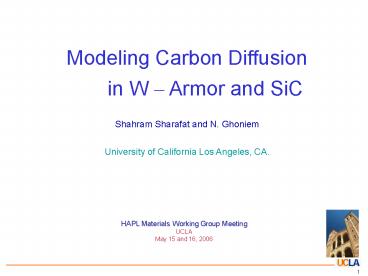Modeling Carbon Diffusion in W - PowerPoint PPT Presentation
1 / 14
Title:
Modeling Carbon Diffusion in W
Description:
Use spatial Carbon implantation profile at time t=0 ... Quasi Steady State Carbon Concentration: ... The high W-surface layer temperatures facilitate C diffusion in W. ... – PowerPoint PPT presentation
Number of Views:37
Avg rating:3.0/5.0
Title: Modeling Carbon Diffusion in W
1
Modeling Carbon Diffusion in W Armor and
SiC Shahram Sharafat and N. Ghoniem University
of California Los Angeles, CA.
HAPL Materials Working Group Meeting UCLAMay
15 and 16, 2006
2
OUTLINE
- Current Capabilities (7 slides)
- Since 14th HAPL (2 slides)
- Planned Improvements (1 slide)
3
Current Capabilities
- Model the Carbon buildup using multi-physics PDE
- (1) Carbon mass diffusion combined and
- (2) temperature evolution
- Use spatial Carbon implantation profile at time
t0 - Use end of shot temperature profile at time t0
- Determine Carbon buildup in tungsten armor
Carbon Implantation Profile
4
Carbon Diffusion Model
- Consider only Carbon Diffusion with R 0
- No WC or W2C formation
Carbon Diffusion in Tungsten ?
http//FusionNET.seas.ucla.edu
(Eckstein, 1999)
5
Carbon Concentration Profile
6
Carbon Concentration Profile
7
Quasi Steady State Diffusion Approximation
- Quasi Steady State Parameters
- Carbons per shot 1.07 ? 1019 ions
- Avg. Carbon Flux (r10.1 m, 10 Hz) 8.35 ?
1016 m-2 s-1 - Avg. W-Temperature (50 um) 500 oC
- Diffusion Pre-exponential (Do) 3.15 ?107 m2 s-1
- Activation Energy (Q) 1.78 eV
8
Current Capabilities
- Model the Carbon buildup using multi-physics PDE
- (1) Carbon mass diffusion combined and
- (2) temperature evolution
- Use spatial Carbon implantation profile at time
t0 - Use end of shot temperature profile at time t0
- Determine Carbon buildup in tungsten armor
Carbon Buildup Profile
Carbon Implantation Profile
9
Carbon Diffusion Observations
- The high W-surface layer temperatures facilitate
C diffusion in W. - Carbon does not preferentially diffuse out from
surface but also spreads inwards (towards F82H). - C-to-W ratio of 1 can be reached in lt10 days (2
mm at 10 Hz r 10.1 m, 405 MJ). - Quasi Steady State Analysis shows that F82H steel
wall is protected from C pickup (C reaches 20
um lt 1 year). - Formation of W2C and WC was not considered
(would slow C-diffusion until C/W ratio gt 1). - Evaporation of C from WC surface was not
considered It would increase C loss from
surface WC?W2C above 2000 oC(1).
1Yamada, JNM 2000
10
Since 14th HAPL
- Accumulated thermodynamic properties of WC and
W2C (formation energies and solubility limits) - Set up model to include reactions between W and
C. - Based on solubility limits of C in W (at 2000 oC
0.05 at. ) all Carbon is consumed in
reactions. - Revisited C diffusion in SiC
11
WC and W2C Formation
Solubility of C in W
- Need Experiments with WC including the effects of
H and He implantation on - Mechanical Properties of WC
- Helium and Hydrogen Release
UCLA FusionNETWORK fusionNET.seas.ucla.edu
- At 2000 oC solubility of C in Tungsten is of the
order of 0.05 at.
12
Carbon Implantation in SiC
Implantation of 12C per shot
- Carbon Implantation range 1.75 mm
- Number of C per shot 6.8x1019 C/shot
- After 1x106 shots (1.2 days) C/SiC ratio
approaches unity (or SiC2) assuming no diffusion
- Concerns Regarding Excess Carbon in SiC
- Carbon diffuses readily (int.
substit./detrapping) - Carbon can bond chemically with H, D, and T
- Formation of Hydro-carbons CxHy ?T retention?
Huanchen, Ghoniem 1994
- Chemical Trapping of H, D, T slows down proton
diffusion, defect annealing, and may interact
synergistically with He - Pursuing rate of Hydro-Carbon formation
13
Planned Improvements
- Complete modeling of WC and W2C formation in
multi-physics analysis of C-diffusion - Expecting less of a spread of Carbon ? highly
localized WC formation (implantation profile may
be maintained until W/C 1) - Investigate effects of simultaneous H
implantation ? will H compete with W for Carbon
?? - Model C diffusion in SiC using Multi-physics PDE
solver.
14
WC-W2C Thermo-Mechanical Impact
- Concerns
- Lower KIC , s affects mechanical response (crack
nucl. growth). - Lower k, Tm may impacts thermal performance of
FW. - High C-content might impact Tritium release rates
- W2C forms at 800 oC and WC forms(1) at 1000 oC
- Helium release from WC above 1200 oC is similar
to W(2).
2 SiC-B4C data Hino-JNM-1999
1Hatano 2005 Roth 2001































